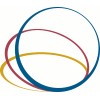
Novel Amblyopia Treatment With Virtual Reality Games
AmblyopiaThe goal of this study is to compare the change in amblyopic eye acuity between treatment periods in children with amblyopia, aged 5-17 years. The main question it aims to answer is: Is a 16-week course of amblyopia treatment using Vivid Vision Therapeutic (Dichoptic) Virtual Reality Games for approx. 25 min/day, 6 days/week more effective for improvement in amblyopic-eye VA, binocularity (stereoacuity, suppression, alignment), contrast sensitivity, attention, oculomotor function, visual-motor integration, and quality of life than 16 weeks of continued glasses alone? Participants will each serve as their own control and complete: Treatment period 1: Continued optical correction (glasses) alone for 16 weeks; Treatment period 2: Vivid Vision Therapeutic (Dichoptic) Virtual Reality Games for 16 weeks (approx. 25min/day, 6 days/week) plus continued optical correction

Optical Correction and Visual Functions of Adults With Amblyopia
AmblyopiaAmblyopia is a developmental anomaly resulting from abnormal visual experiences in early life. Amblyopia causes reduced visual acuity in the absence of a pathology. Adult sensory systems are believed to be structurally invariant beyond early, critical periods of development. However, recent evidence suggest that visual functions in adults with amblyopia can be improved with optical correction alone. This study aims to investigate whether improvements in best corrected visual acuity and other visual functions can result following appropriate optical correction in adults with amblyopia. Functional measures relating to vision, binocular vision, and eye movements will be used to assess the efficacy of refractive correction for improving vision. This study will help us better understand the improvements in visual functions following optical correction, as well as the mechanisms underlying neuroplasticity in adults with amblyopia.

Binocular Amblyopia Treatment
AmblyopiaTo evaluate the effectiveness of enhanced binocular amblyopia treatments in achieving a more complete and stable recovery.

Binocular Visual Therapy and Video Games for Amblyopia Treatment.
AmblyopiaAmblyopia, or lazy eye, is best defined by the American Academy of Ophthalmology as a unilateral or bilateral reduction of the best corrected visual acuity that occurs in the setting of an otherwise normal eye, or a structural abnormality involving the eye or visual pathway with reduction in visual acuity that cannot be attributed only to the effect of the structural abnormality. Which causes an abnormal visual experience early in life, with consequences such as deficiencies in the ability to perceive contrast and/or movement, visual acuity, accommodation and stereopsis. The treatment of choice consists in patching of the fellow eye 2 hours per day. The disadvantage of this treatment modality is that patients end up not complying and when treatment is interrupted, lazy eye reappears. Amblyopia was thought to be a monocular disease, now a days there are reports of cortical visual paths changes in both eyes (the fellow and amblyopia eye), believing that it might be a monocular consequence of a binocular disease. Following that statement new treatment studies have arisen, stimulating both eyes not only to improve visual acuity in the lazy eye, but to restore binocular function as well. These treatments use videogames in celular phones, computers, or tablets where the fellow eye is exposed to reduced contrast and the lazy eye is exposed to full-contrast. Although the evidence is promising, more studies are needed to establish effectivity and security of this treatment modality.

NEIVATECH Virtual Reality-based System for Amblyopia
AmblyopiaThe NEIVATECH system has been designed to provide binocular vision training to 7-15 year old amblyopic children by discriminating Gabor patches presented with different contrast to each eye as a perceptual learning task.

Real Word Study on Myopia Control With Repeated Red Light Therapy for Ages of 3~6 Years Old
MyopiaAmblyopiaRepeated Red Light Therapy had been used as an amblyopia therapy for children as well as the myopia control in primary schools. However, ultra low lever of red light therapy with irradiance of 0.37mW and 0.60mW effectiveness and safety for 3~ 6 year-old myopia treatment or slow myopia progression are seldom reported.

Validation of New Virtual Reality Treatment for Children With Lazy Eye Using the Vedea Amblyopia...
AmblyopiaAnisometropic2 moreThe purpose of this clinical study is to validate the effectiveness of the Vedea Amblyopia Therapy (VAT) as a treatment for children with lazy eye. The main question it aims to answer is to prove that the VAT is as effective or more effective than the current gold standard for treating children with lazy eye. This is occlusion therapy by patching the dominant eye. Participants will play VR-games specifically designed for children with lazy eye for 30 minutes per day, 5 days per week for 16 weeks. This group of children will be compared to children that undergo regular occlusion therapy to see how both treatments options compare.

Effectiveness of Virtual Reality Training in Amblyopia
AmblyopiaThe goal of this clinical trial is to evaluate the efficacy and safety of visual function training software (model: SJ-JRS2021) in the treatment of mild to moderate amblyopia in children. The main questions it aims to answer are: Whether virtual reality training is more effective than occlusion therapy Safety of virtual reality training in amblyopia treatment If participants have refractive problems, correct the refraction first and wear corrective glasses. The experimental group will be treated using visual function training therapy software (model: SJ-JRS2021). The control group will be treated with occlusion therapy covering the contralateral eye for 2 hours a day. Researchers will compare experimental group with control group to see if the experimental group has better corrected vision recovery.

A Randomized Trial to Evaluate Sequential vs Simultaneous Patching
AmblyopiaA randomized trial to determine whether simultaneous treatment with spectacles and patching has an equivalent VA outcome compared with sequential treatment, first with spectacles alone followed by patching (if needed), for previously untreated amblyopia in children 3 to <13 years of age.

OCT Eccentric Fixation and Amblyopia in Children
AmblyopiaThe objectives of this proposal are to characterize the relationship between OCT eccentric fixation (OCT-EF), fixation eye movement (FEM), macular sensitivity in children with amblyopia.
